Broadband Perfect Optical Absorption by Coupled Semiconductor Resonator-Based All-Dielectric Metasurface
Abstract
1. Introduction
2. Theory, Models, and Results
2.1. Narrowband Perfect Optical Absorption All-Dielectric Metasurface
2.2. Broadband Perfect Optical Absorption All-Dielectric Metasurface
3. Conclusions
Author Contributions
Funding
Conflicts of Interest
References
- Landy, N.; Sajuyigbe, S.; Mock, J.; Smith, D.; Padilla, W. Perfect metamaterial absorber. Phys. Rev. Lett. 2008, 100, 207402. [Google Scholar] [CrossRef] [PubMed]
- Liu, X.; Starr, T.; Starr, A.; Padilla, W. Infrared spatial and frequency selective metamaterial with near-unity absorbance. Phys. Rev. Lett. 2010, 104, 207403. [Google Scholar] [CrossRef] [PubMed]
- Guo, Y.; Hou, X.; Lv, X.; Bi, K.; Lei, M.; Zhou, J. Tunable artificial microwave blackbodies based on metasurfaces. Opt. Express 2017, 25, 25879–25885. [Google Scholar] [CrossRef]
- Guo, Y.; Li, J.; Hou, X.; Lv, X.; Liang, H.; Zhou, J. A simple topology metamaterial blackbody for visible light. J. Alloys Compd. 2017, 699, 998–1002. [Google Scholar] [CrossRef]
- Shrekenhamer, D.; Chen, W.; Padilla, W. Liquid crystal tunable metamaterial absorber. Phys. Rev. Lett. 2013, 110, 177403. [Google Scholar] [CrossRef] [PubMed]
- Liu, N.; Mesch, M.; Weiss, T.; Hentschel, M.; Giessen, H. Infrared perfect absorber and its application as plasmonic sensor. Nano Lett. 2010, 10, 2342–2348. [Google Scholar] [CrossRef]
- Janneh, M.; De Marcellis, A.; Palange, E.; Tenggara, A.; Byun, D. Design of a metasurface-based dual-band Terahertz perfect absorber with very high Q-factors for sensing applications. Opt. Commun. 2018, 416, 152–159. [Google Scholar] [CrossRef]
- Rifat, A.; Rahmani, M.; Xu, L.; Miroshnichenko, A. Hybrid metasurface based tunable near-perfect absorber and plasmonic sensor. Materials 2018, 11, 1091. [Google Scholar] [CrossRef]
- Li, W.; Valentine, J. Metamaterial perfect absorber based hot electron photodetection. Nano Lett. 2014, 14, 3510–3514. [Google Scholar] [CrossRef]
- Liu, X.; Tyler, T.; Starr, T.; Starr, A.; Jokerst, N.; Padilla, W. Taming the blackbody with infrared metamaterials as selective thermal emitters. Phys. Rev. Lett. 2011, 107, 045901. [Google Scholar] [CrossRef] [PubMed]
- Feng, R.; Ding, W.; Liu, L.; Chen, L.; Qiu, J.; Chen, G. Dual-band infrared perfect absorber based on asymmetric T-shaped plasmonic array. Opt. Express 2014, 22, A335–A343. [Google Scholar] [CrossRef] [PubMed]
- Dincer, F. Electromagnetic energy harvesting application based on tunable perfect metamaterial absorber. J. Electromagn. Waves Appl. 2015, 29, 2444–2453. [Google Scholar] [CrossRef]
- Bakir, M.; Karaaslan, M.; Dincer, F.; Akgol, O.; Sabah, C. Electromagnetic energy harvesting and density sensor application based on perfect metamaterial absorber. Int. J. Mod. Phys. B 2016, 30, 1650133. [Google Scholar] [CrossRef]
- Yin, M.; Tian, X.; Wu, L.; Li, D. A broadband and omnidirectional electromagnetic wave concentrator with gradient woodpile structure. Opt. Express 2013, 21, 19082–19090. [Google Scholar] [CrossRef] [PubMed]
- Muhammad, N.; Fu, T.; Liu, Q.; Tang, X.; Deng, Z.; Ouyang, Z. Plasmonic metasurface absorber based on electro-optic substrate for energy harvesting. Materials 2018, 11, 2315. [Google Scholar] [CrossRef]
- Lin, D.; Fan, P.; Hasman, E.; Brongersma, M. Dielectric gradient metasurface optical elements. Science 2014, 345, 298–302. [Google Scholar] [CrossRef] [PubMed]
- Yang, Y.; Kravchenko, I.I.; Briggs, D.; Valentine, J. All-dielectric metasurface analogue of electromagnetically induced transparency. Nat. Commun. 2014, 5, 5753. [Google Scholar] [CrossRef]
- High, A.; Devlin, R.; Dibos, A.; Polking, M.; Wild, D.; Perczel, J.; de Leon, N.; Lukin, M.; Park, H. Visible-frequency hyperbolic metasurface. Nature 2015, 522, 192–196. [Google Scholar] [CrossRef]
- Staude, I.; Miroshnichenko, A.; Decker, M.; Fofang, N.; Liu, S.; Gonzales, E.; Dominguez, J.; Luk, T.; Neshev, D.; Brener, I.; et al. Tailoring directional scattering through magnetic and electric resonances in subwavelength silicon nanodisks. ACS Nano 2013, 7, 7824–7832. [Google Scholar] [CrossRef]
- Moitra, P.; Slovick, B.; Yu, Z.; Krishnamurthy, S.; Valentine, J. Experimental demonstration of a broadband all-dielectric metamaterial perfect reflector. Appl. Phys. Lett. 2014, 104, 171102. [Google Scholar] [CrossRef]
- Liu, X.; Fan, K.; Shadrivov, I.; Padilla, W. Experimental realization of a terahertz all-dielectric metasurface absorber. Opt. Express 2017, 25, 191–201. [Google Scholar] [CrossRef]
- Cole, M.; Powell, D.; Shadrivov, I. Strong terahertz absorption in all-dielectric Huygens’ metasurfaces. Nanotechnology 2016, 27, 424003. [Google Scholar] [CrossRef] [PubMed]
- Tian, J.; Luo, H.; Li, Q.; Pei, X.; Du, K.; Qiu, M. Near-infrared super-absorbing all-dielectric metasurface based on single-layer germanium nanostructures. Laser Photonics Rev. 2018, 12, 1800076. [Google Scholar] [CrossRef]
- Zhu, W.; Xiao, F.; Kang, M.; Premaratne, M. Coherent perfect absorption in an all-dielectric metasurface. Appl. Phys. Lett. 2016, 108, 121901. [Google Scholar] [CrossRef]
- Li, L.; Wang, J.; Wang, J.; Du, H.; Huang, H.; Zhang, J.; Qu, S.; Xu, Z. All-dielectric metamaterial frequency selective surfaces based on high-permittivity ceramic resonators. Appl. Phys. Lett. 2015, 106, 212904. [Google Scholar] [CrossRef]
- Mitrofanov, O.; Siday, T.; Thompson, R.; Luk, T.; Brener, I.; Reno, J. Efficient photoconductive terahertz detector with all-dielectric optical metasurface. APL Phontonics 2018, 3, 051703. [Google Scholar] [CrossRef]
- Yang, Q.; Chen, X.; Xu, Q.; Tian, C.; Xu, Y.; Cong, L.; Zhang, X.; Li, Y.; Zhang, C.; Zhang, X.; et al. Broadband terahertz rotator with an all-dielectric metasurface. Photonics Res. 2018, 6, 1056–1061. [Google Scholar] [CrossRef]
- Forouzmand, A.; Salary, M.; Inampudi, S.; Mosallaei, H. A tunable multigate Indium-Tin-Oxide-assisted all-dielectric metasurface. Adv. Opt. Mater. 2018, 6, 1701275. [Google Scholar] [CrossRef]
- Owiti, E.; Yang, H.; Liu, P.; Ominde, C.; Sun, X. Polarization converter with controllable birefringence based on hybrid all-dielectric-graphene metasurface. Nanoscale Res. Lett. 2018, 13, 38. [Google Scholar] [CrossRef]
- Liu, S.; Vabishchevich, P.; Vaskin, A.; Reno, J.; Keeler, G.; Sinclair, M.; Staude, I.; Brener, I. An all-dielectric metasurface as a broadband optical frequency mixer. Nat. Commun. 2018, 9, 2507. [Google Scholar] [CrossRef]
- Huang, Y.; Xu, H.; Lu, Y.; Chen, Y. All-dielectric metasurface for achieving perfect reflection at visible wavelengths. J. Phys. Chem. C 2018, 122, 2990–2996. [Google Scholar] [CrossRef]
- Guo, Y.; Liu, S.; Bi, K.; Lei, M.; Zhou, J. Low-power nonlinear enhanced electromagnetic transmission of a subwavelength metallic aperture. Photonics Res. 2018, 6, 1102–1106. [Google Scholar] [CrossRef]
- Kinsey, N.; DeVault, C.; Kim, J.; Ferrera, M.; Shalaev, V.; Boltasseva, A. Epsilon-near-zero Al-doped ZnO for ultrafast switching at telecom wavelengths. Optica 2015, 2, 616–622. [Google Scholar] [CrossRef]
- Naik, G.; Shalaev, V.; Boltasseva, A. Alternative plasmonic materials: Beyond gold and silver. Adv. Mater. 2013, 25, 3264–3294. [Google Scholar] [CrossRef] [PubMed]
- Guo, Y.; Zhou, J. Dual-band-enhanced transmission through a subwavelength aperture by coupled metamaterial resonators. Sci. Rep. 2015, 5, 8144. [Google Scholar] [CrossRef]
- Guo, Y.; Zhou, J. Total broadband transmission of microwaves through a subwavelength aperture by localized E-field coupling of split-ring resonators. Opt. Express 2014, 22, 27136–27143. [Google Scholar] [CrossRef] [PubMed]
- Guo, Y.; Zhou, J.; Lan, C.; Wu, H.; Bi, K. Mie-resonance-coupled total broadband transmission through a single subwavelength aperture. Appl. Phys. Lett. 2014, 104, 204103. [Google Scholar]
- Sample, A.; Meyer, D.; Smith, J. Analysis, experimental results, and range adaptation of magnetically coupled resonators for wireless power transfer. IEEE Trans. Ind. Electron. 2011, 58, 544–554. [Google Scholar] [CrossRef]
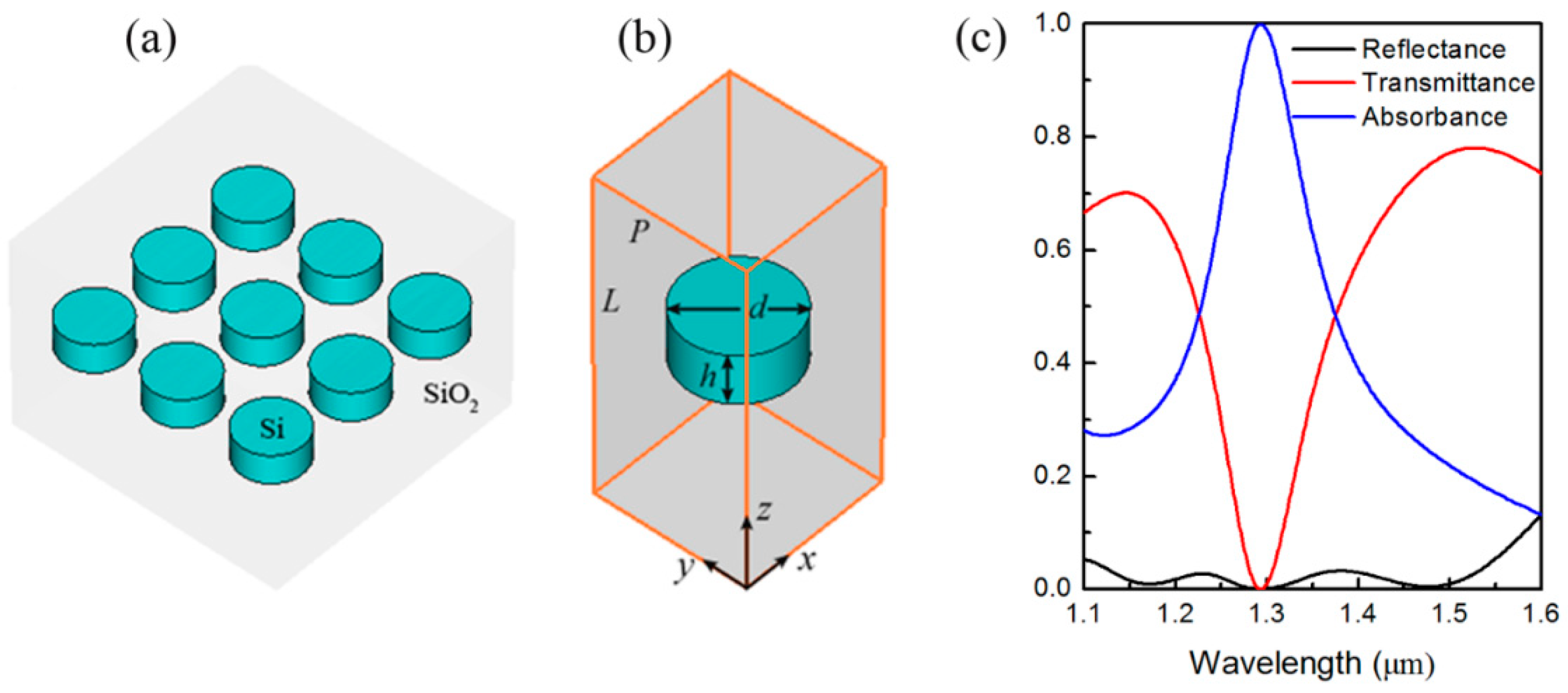
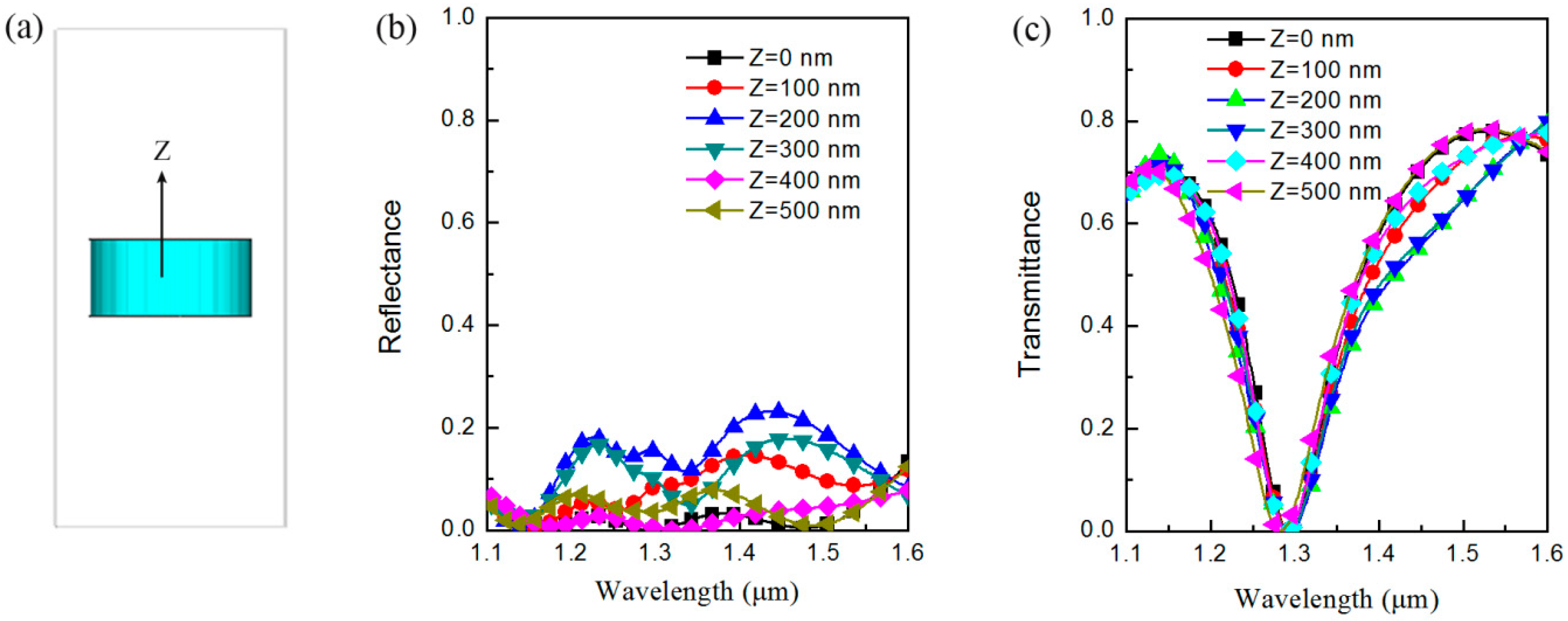
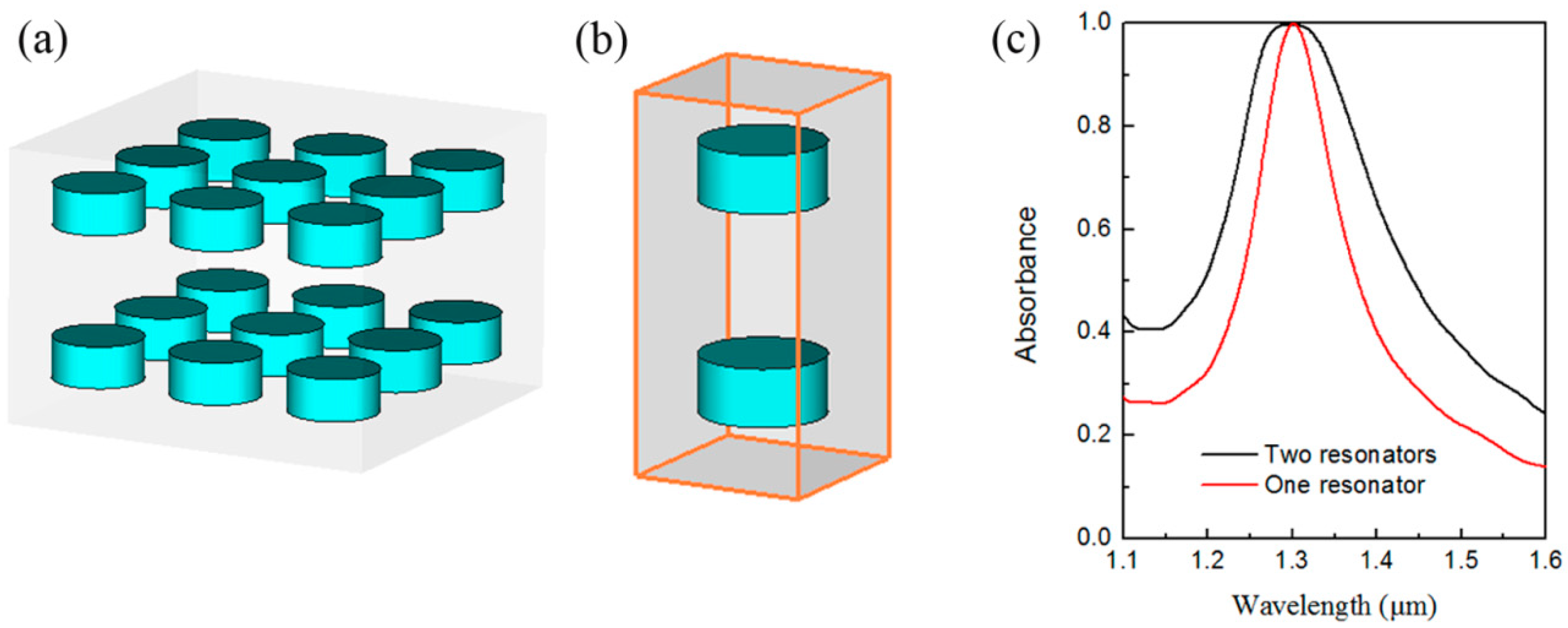
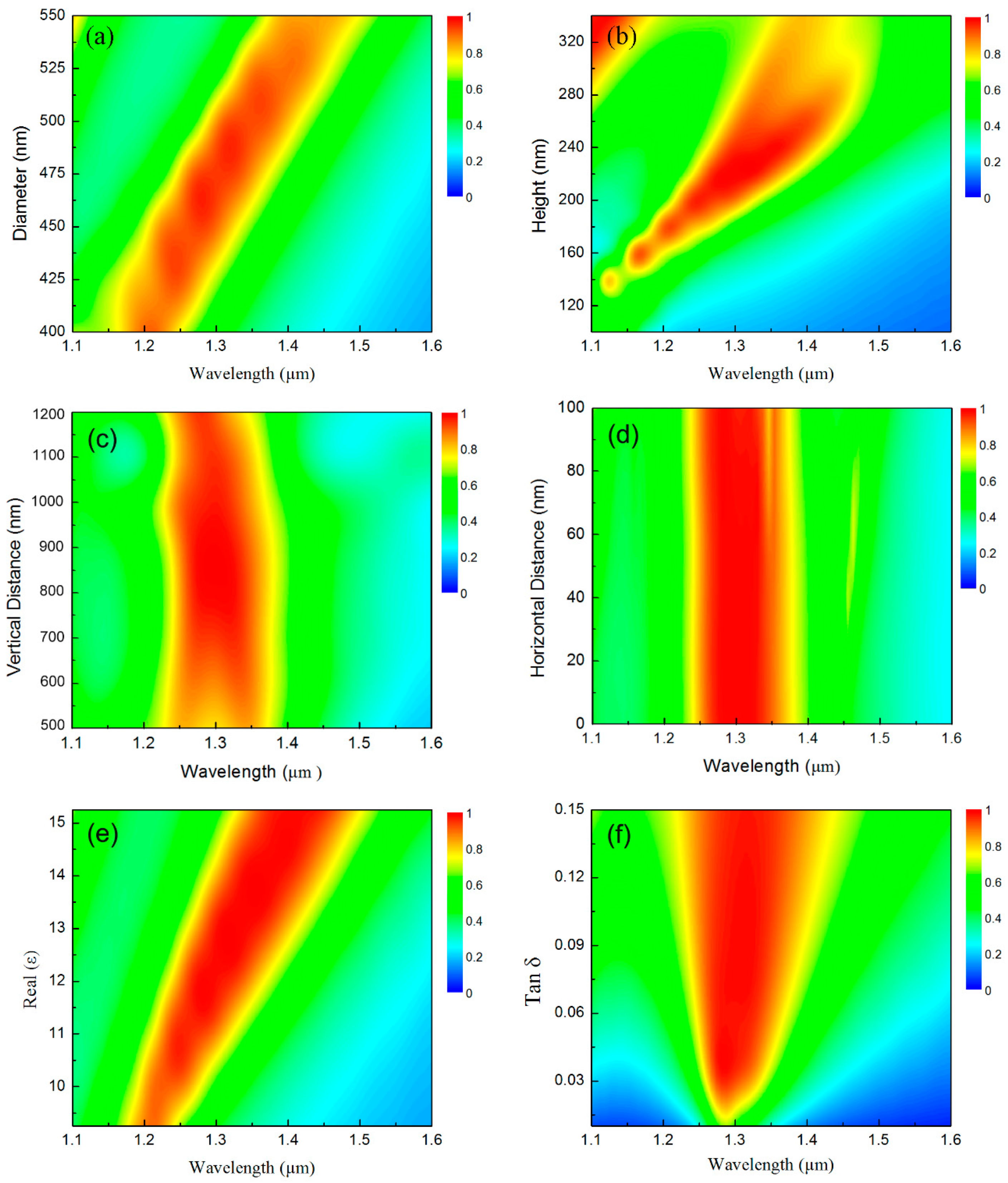
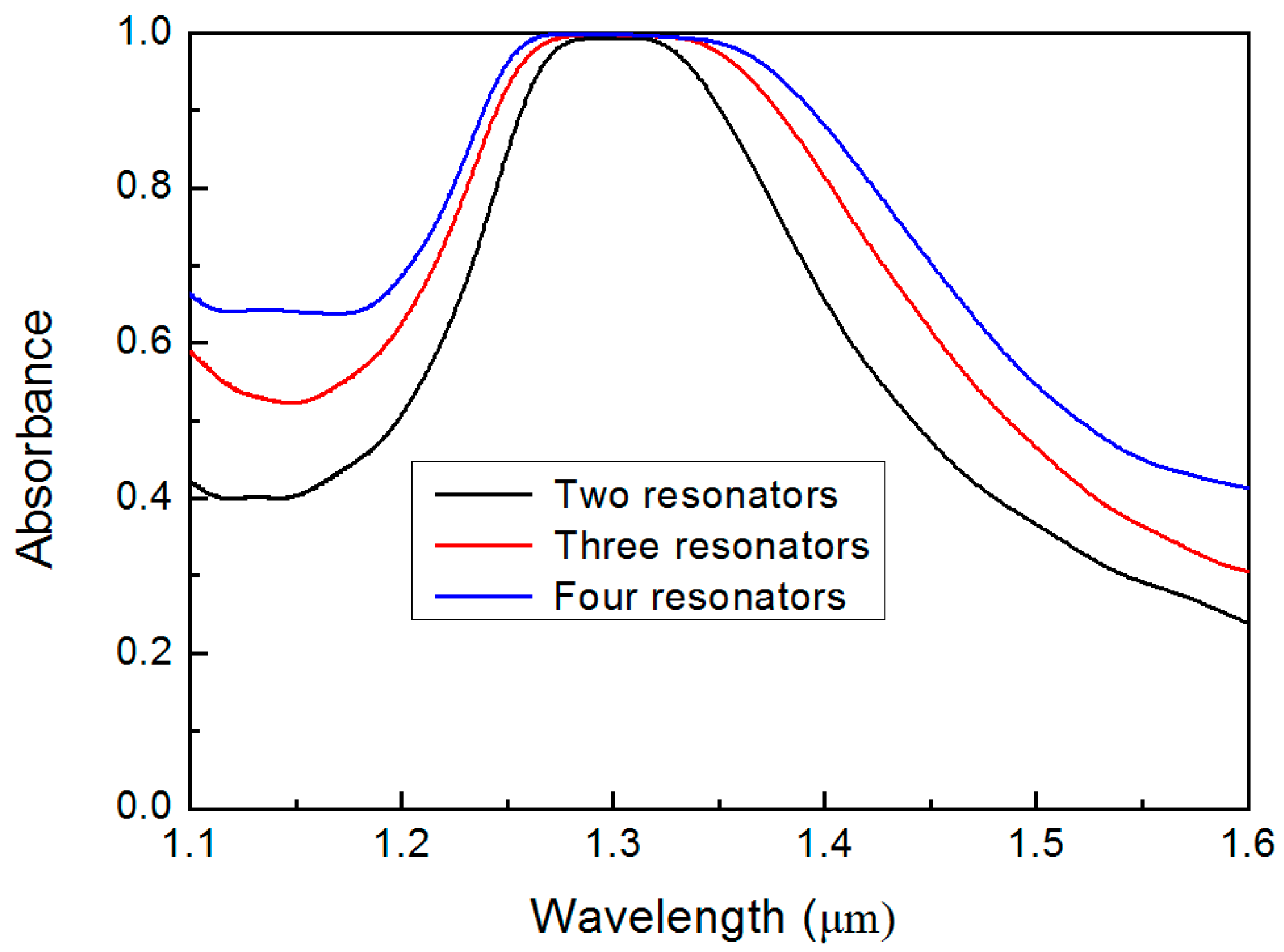
© 2019 by the authors. Licensee MDPI, Basel, Switzerland. This article is an open access article distributed under the terms and conditions of the Creative Commons Attribution (CC BY) license (http://creativecommons.org/licenses/by/4.0/).
Share and Cite
Weng, Z.; Guo, Y. Broadband Perfect Optical Absorption by Coupled Semiconductor Resonator-Based All-Dielectric Metasurface. Materials 2019, 12, 1221. https://doi.org/10.3390/ma12081221
Weng Z, Guo Y. Broadband Perfect Optical Absorption by Coupled Semiconductor Resonator-Based All-Dielectric Metasurface. Materials. 2019; 12(8):1221. https://doi.org/10.3390/ma12081221
Chicago/Turabian StyleWeng, Zhi, and Yunsheng Guo. 2019. "Broadband Perfect Optical Absorption by Coupled Semiconductor Resonator-Based All-Dielectric Metasurface" Materials 12, no. 8: 1221. https://doi.org/10.3390/ma12081221
APA StyleWeng, Z., & Guo, Y. (2019). Broadband Perfect Optical Absorption by Coupled Semiconductor Resonator-Based All-Dielectric Metasurface. Materials, 12(8), 1221. https://doi.org/10.3390/ma12081221



